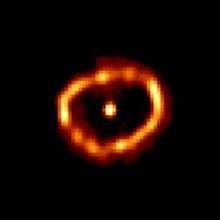V1974 Cygni
V1974 Cygni or Nova Cygni 1992 was a relatively bright nova in the constellation Cygnus.
| Observation data Epoch J2000.0 Equinox J2000.0 | |
|---|---|
| Constellation | Cygnus |
| Right ascension | 20h 30m 31.58s |
| Declination | 52° 37′ 53.4″ |
| Apparent magnitude (V) | (+4.4 max) |
| Distance | 10,430 ly (3,200 pc) |
| Spectral type | (neon nova) |
| Other designations | |
Nova Cygni 1992 | |

Cygni 1992, NASA (taken January 1994)
It was discovered on February 19, 1992, by Peter Collins. At that time it was magnitude 6, the maximum magnitude reached was 4.4. The hydrogen burning on the white dwarf ended two years later, in 1994. This nova was a neon nova. It is the first nova observed from onset to completion, and can be calculated to be 10,430 light years away from Earth.
It was also studied with the Hubble Space Telescope instrument the High Speed Photometer.[1] The instrument recorded a short amount of ultraviolet photometry.[1] The nova was also observed in the far-ultraviolet by Voyager 2.[2]
See also
- Nova Cygni 1975
References
- Ultraviolet photometry of Nova Cygni 1992 obtained with the high speed photometer
- Ulivi, Paolo; Harland, David M (2007). Robotic Exploration of the Solar System Part I: The Golden Age 1957-1982. Springer. p. 449. ISBN 9780387493268.
External links
- https://web.archive.org/web/20050915104557/http://www.tsm.toyama.toyama.jp/curators/aroom/var/nova/1990.htm
- http://www.aavso.org/v1974-cyg-nova-cygni-1992
This article is issued from Wikipedia. The text is licensed under Creative Commons - Attribution - Sharealike. Additional terms may apply for the media files.